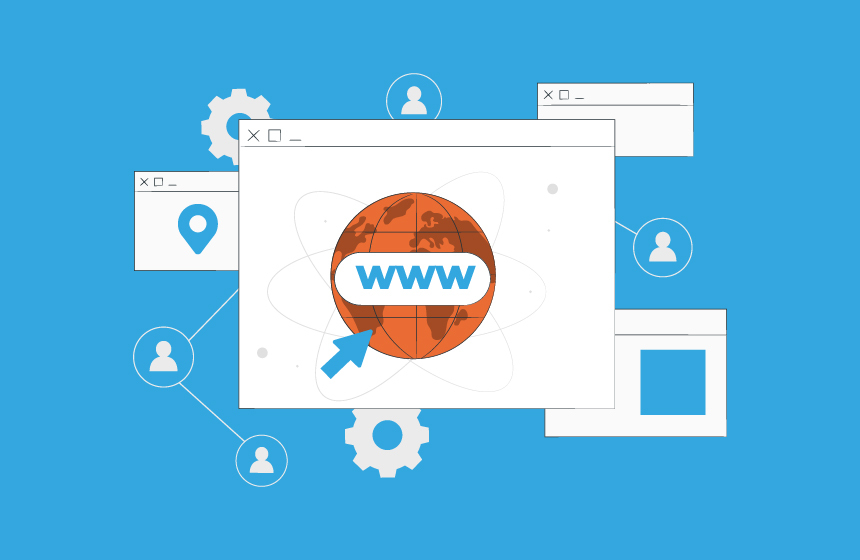Ever found yourself lost in the maze of domain names, wondering how those magical web addresses come to be?
Well, fear not because we’re about to embark on a journey to demystify the intricate world of domain registration to help you buy a domain strategically.
Your online presence is as crucial as a first impression, and it all starts with that unique web address. Whether you’re a seasoned webmaster or just dipping your toes into the vast ocean of the internet, understanding the ins and outs of domain registration is like holding the map to the online universe.
By the end of this guide, you’ll be wielding the knowledge to navigate the domain registration landscape like a pro. Ready to dive in? Let’s demystify domain registration together!
Table of Contents
Basics of Domain Names
Welcome to the domain naming playground! Before you embark on the thrilling journey of registering your own, let’s break down the basics of what makes up these digital addresses.
Anatomy of a Domain Name
Imagine a domain name as the street address of your online home. It’s not just a random sequence of characters; each part has a specific role:
Subdomain: The optional prefix before the main domain, often used for specific sections like “blog” or “shop.”
Domain Name: The unique and central part of your web address.
Top-Level Domain (TLD): The .com, .net, or .org at the end, signalling the category or purpose of the website.
Understanding this structure is key to crafting a memorable and effective domain name.
Types of Top-Level Domains (TLDs)
Domains come in all shapes and sizes, and TLDs play a starring role. Let’s categorise them for a clearer picture:
Generic TLDs (gTLDs): The classics like .com, .net, and .org, suitable for a wide range of websites.
Country Code TLDs (ccTLDs): Country-specific domains like .us or .uk, perfect if your website targets a particular geographic audience.
New gTLDs: The trendy newcomers such as .app, .blog, or .guru, offer a fresh and specific approach.
The Domain Registration Process
Now that we’ve got a grip on the ABCs of domain names, let’s navigate the exciting terrain of actually claiming your spot in the digital landscape. The domain registration process is like claiming your own piece of the internet real estate, and here’s your step-by-step guide:
Choosing a Registrar
Think of a domain name registrar as your friendly real estate agent in the online world. You’ll need to choose a reliable one to facilitate the registration process. Hosting.co.uk is your best domain registrar partner.
Availability Check
Not all great names are available, so it’s time for a digital treasure hunt. Use the hosting.co.uk’s domain search tool to check if your desired domain is up for grabs. Be prepared with alternatives, just in case your first choice is already taken.
Selecting the Right Domain Name
This is where the creative juices flow. Your domain name is your brand, so make it memorable, relevant, and easy to spell. Consider your niche, target audience, and future growth. A well-chosen domain is the first step to standing out in the crowded online world.
Registration Duration and Renewal
Once you’ve found the perfect domain, it’s time to seal the deal. Decide on the registration duration, usually in yearly increments. Keep an eye on the renewal process, as forgetting it could lead to losing your precious domain. Most registrars offer auto-renewal options for peace of mind.
WHOIS Database
The mysterious world of WHOIS – the digital phonebook of the internet. Let’s shine a light on what it is and why it matters in the realm of domain registration.
WHOIS is like the public record for domains. It holds crucial information about domain owners, their contact details, and when the domain was created and expires. Think of it as the transparency window of the online realm, providing a glimpse into the behind-the-scenes of domain ownership.
Privacy Concerns and Domain Registration
While WHOIS is a valuable tool, it also raises privacy concerns. When you register a domain, your personal information becomes visible to anyone who queries the WHOIS database. To address this, many registrars offer WHOIS privacy protection services, replacing your details with generic information to safeguard your privacy.
Navigating the WHOIS database is akin to flipping through the pages of an online directory.
Domain Ownership and Management
Congratulations on securing your digital real estate! Now, let’s dive into the responsibilities and perks that come with being a domain owner.
Registrant, Administrative, and Technical Contacts
Understanding the roles in domain ownership is crucial.
Registrant: That’s you—the proud owner! Your name, address, and other contact info reside here.
Administrative Contact: The go-to person for managing the domain, often the registrant or a delegated representative.
Technical Contact: Handles technical aspects like domain name system (DNS) settings.
Transferring Domain Ownership
Life changes, and so might your need to transfer ownership. Whether selling, gifting, or business restructuring, most registrars provide straightforward processes for transferring domain ownership. Know the rules and safeguards to ensure a smooth transition.
Managing Domain Settings
Your domain is not a static entity; it’s a dynamic part of your online identity. Dive into your registrar’s dashboard to manage settings like
DNS Configuration: Directs your domain to the correct servers.
Domain Forwarding: Forwards traffic from one domain to another.
Auto-Renewal: Never lose your domain due to forgetfulness.
Owning a domain is akin to owning a house—it comes with ongoing tasks.
Domain Registration Costs
Now, let’s talk numbers—the investment required to claim your spot in the digital realm. Understanding the costs associated with domain registration ensures you make informed decisions.
Initial Registration Fees: Securing your dream domain comes with an initial cost. Prices vary based on factors like the chosen top-level domain (TLD), registrar, and any premium features you opt for.
Renewal Fees: Owning a domain is not a one-time expense. Most domains are leased annually, and renewal fees kick in to keep your ownership intact. Keep track of renewal dates and set up auto-renewal to avoid unintentional lapses that could lead to losing your domain.
Hidden Costs and Add-ons: Beware of the fine print! Some registrars may lure you in with low initial fees but charge extra for essential features like privacy protection, email hosting, or security certificates. Scrutinise the package details to ensure you’re getting everything you need without surprise costs.
As we peel back the layers of domain intricacies, our next stop is exploring the vital topic of domain security.
Domain Security
Your domain is not just an address; it’s the gateway to your online presence. Protecting it is paramount. Unsecured domains are vulnerable to various threats like hacking, unauthorised transfers, and identity theft. Understand the risks, and let’s armour up!
Two-Factor Authentication (2FA): Activate the digital moat around your domain by enabling two-factor authentication. This adds an extra layer of protection beyond passwords. Typically, it involves receiving a code on your phone or email to verify your identity during login attempts.
Domain Locking: Imagine locking the doors to your digital castle. Domain locking prevents unauthorised transfers and changes to your domain settings. It adds an extra layer of defence, ensuring that only authorised personnel can make alterations.
Domain Expiry and Redemption
Picture this: your online fortress, the domain you’ve nurtured and protected over time. Now, let’s unravel what happens when the clock ticks towards domain expiration and the redemption journey begins.
Grace Periods: When a domain expires, it doesn’t vanish immediately. Most registrars offer a grace period—a buffer zone after expiration. During this period, you can still renew your domain without losing ownership. However, beware that some services may be temporarily disabled.
Redemption Period: Missed the grace period? Don’t panic just yet. The redemption period follows, offering a last chance to reclaim your domain. Keep in mind, though, this phase comes with additional fees. It’s like rescuing your digital asset from the brink but at a cost.
Domain Auctions: If all else fails and the redemption period slips by, your domain might enter the auction block. Domain auctions allow others to bid on and potentially acquire your expired domain. To avoid this scenario, meticulous management and timely renewals are your best allies.
Conclusion
And there you have it, intrepid navigators of the digital seas! We’ve journeyed through the intricate landscape of domain registration, from understanding the basics to securing and managing your online identity.
Now, as you embark on claiming your own slice of the internet, we have an exclusive offer just for you. Head over to Hosting.co.uk and explore a myriad of domain options, from the classic .com to the trendy .online. All prices are in pounds (£) without tax, ensuring transparent transactions.
But wait, there’s more! For a limited time, seize the opportunity to register your .xyz domain for just $16.99 without VAT. Unleash your creativity and register as many .xyz domains as your heart desires.
Your online journey awaits, and with Hosting.co.uk, securing your digital home has never been more accessible.

